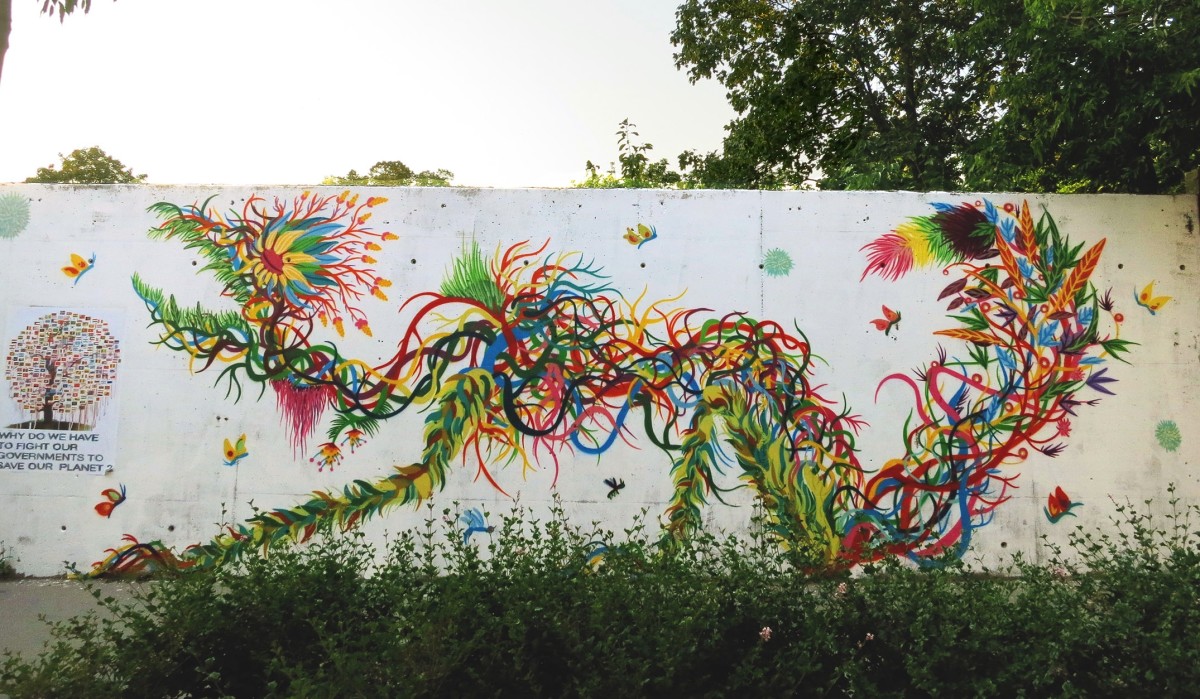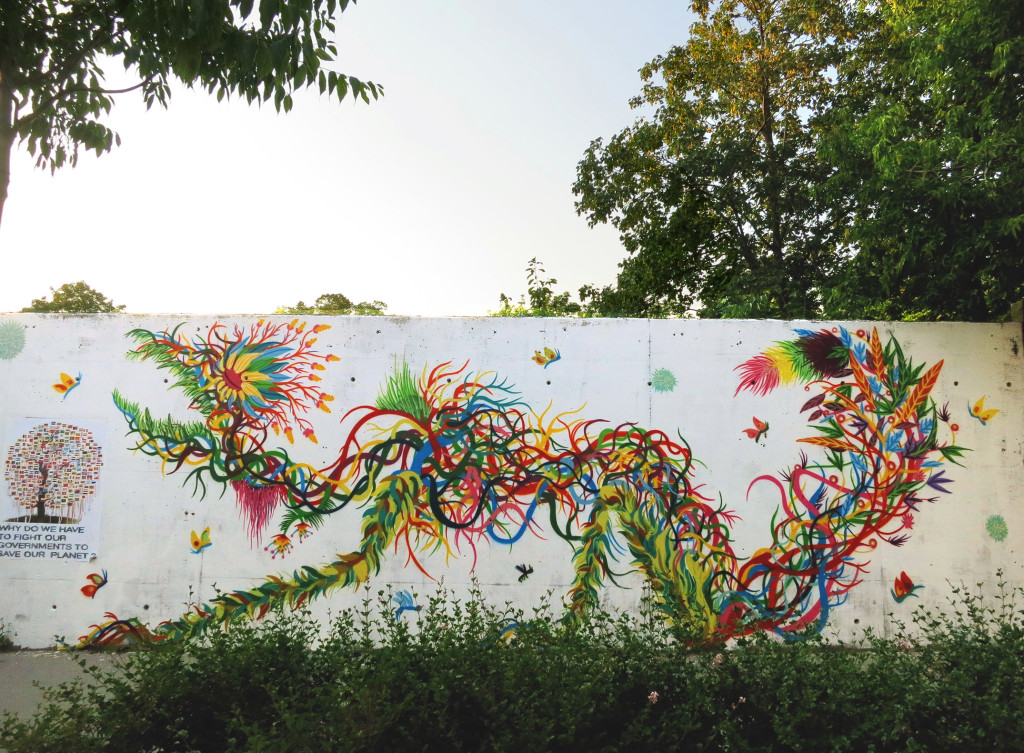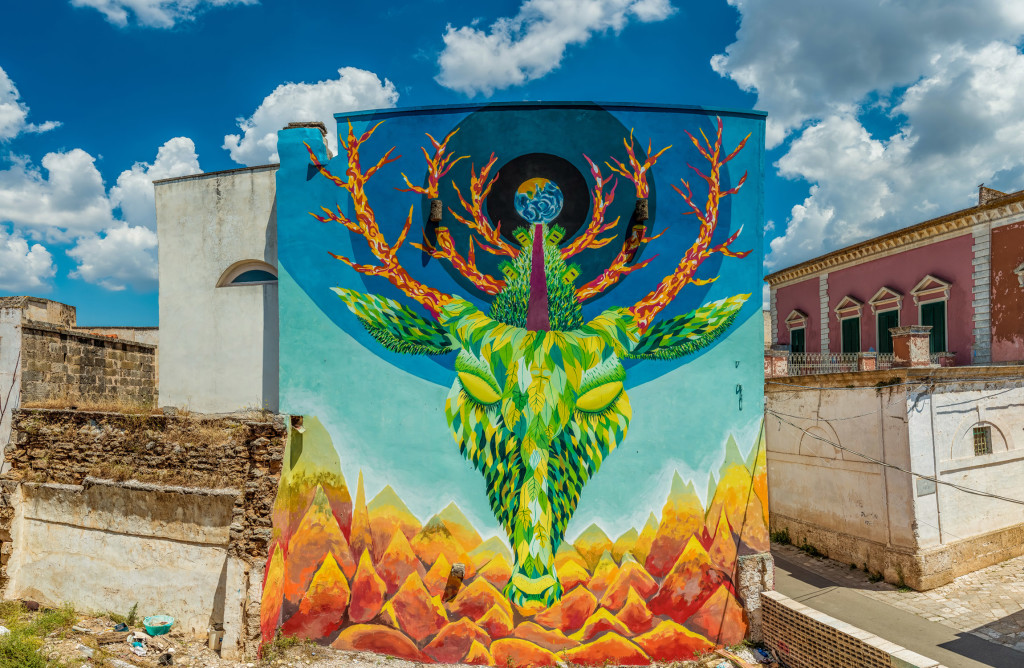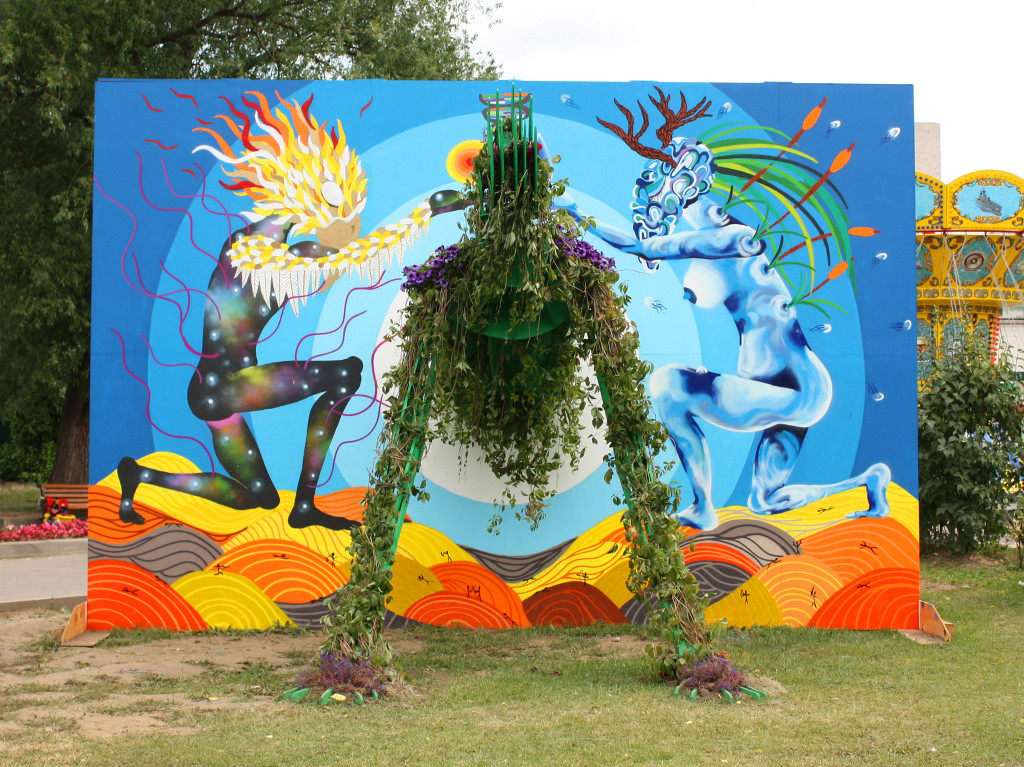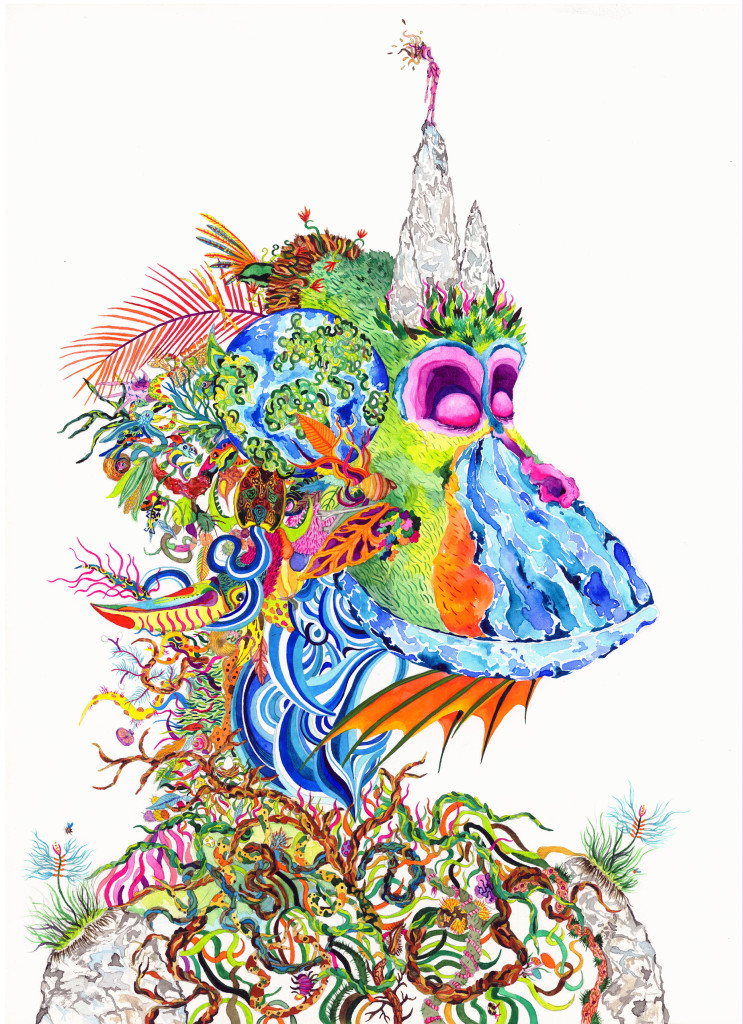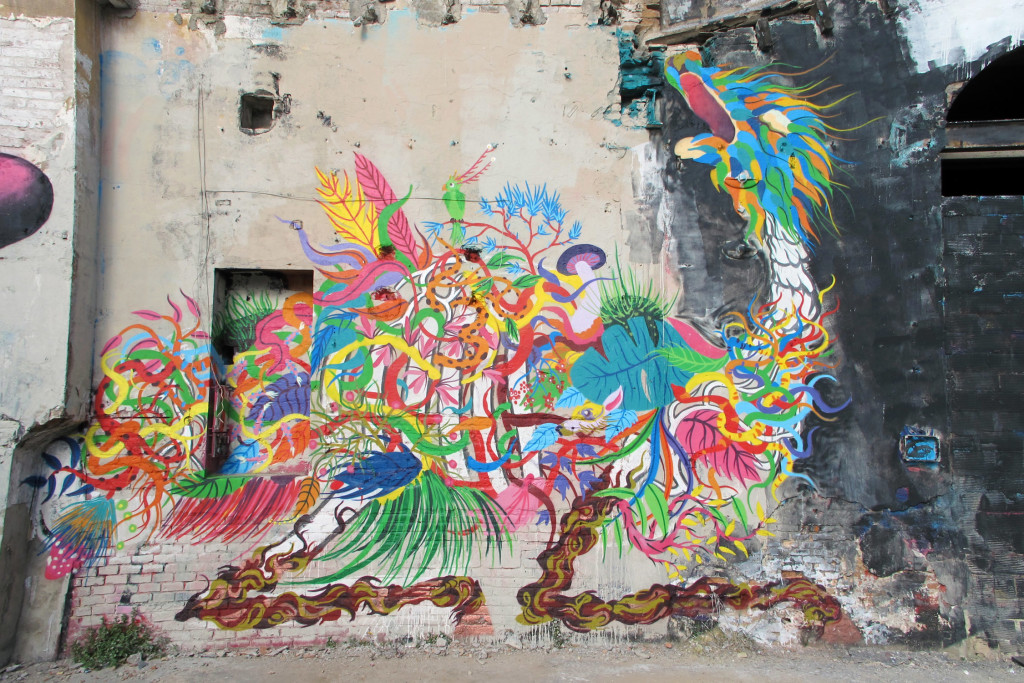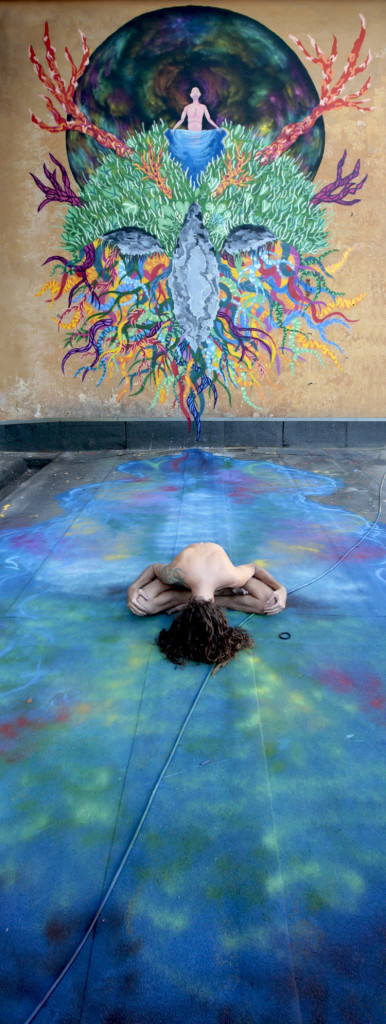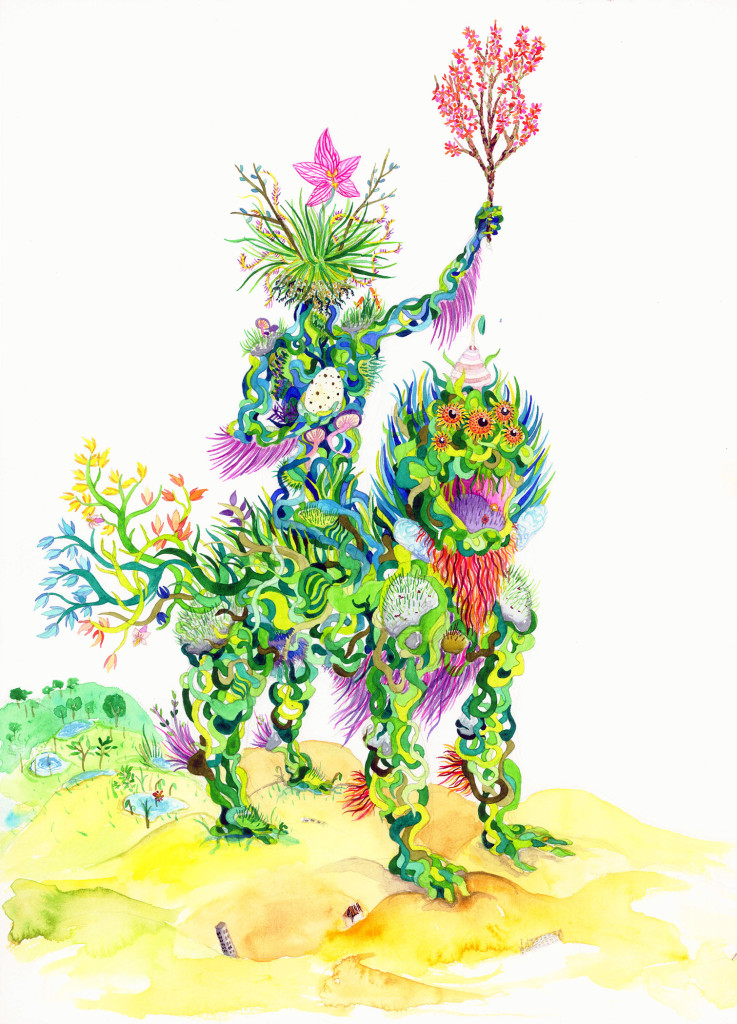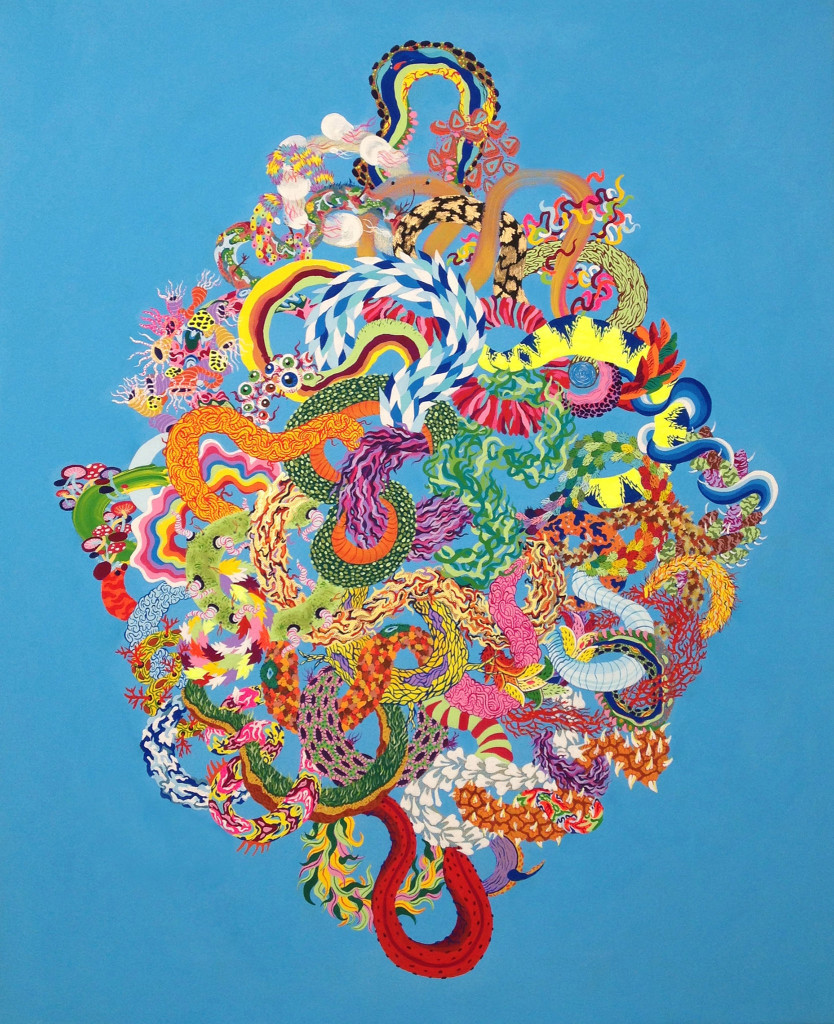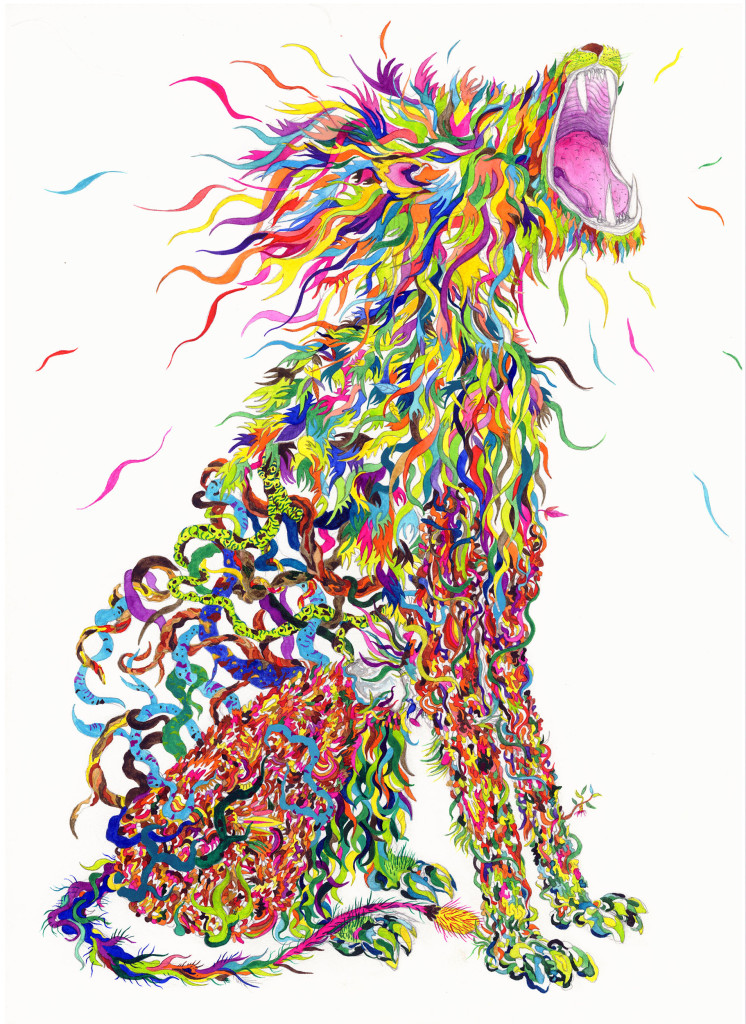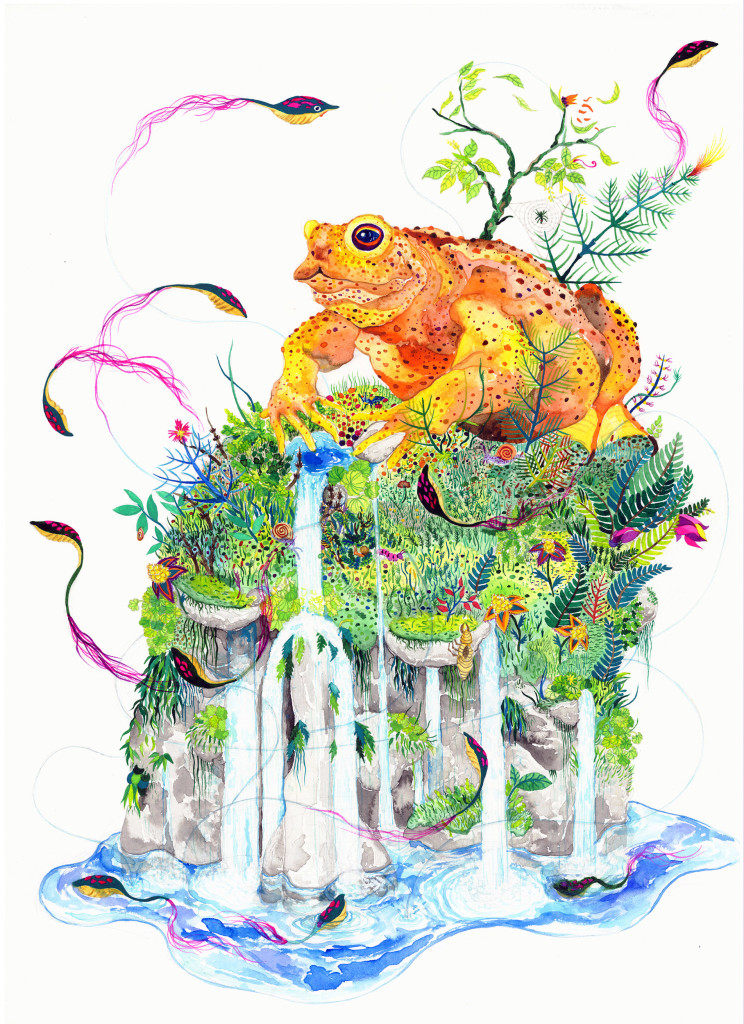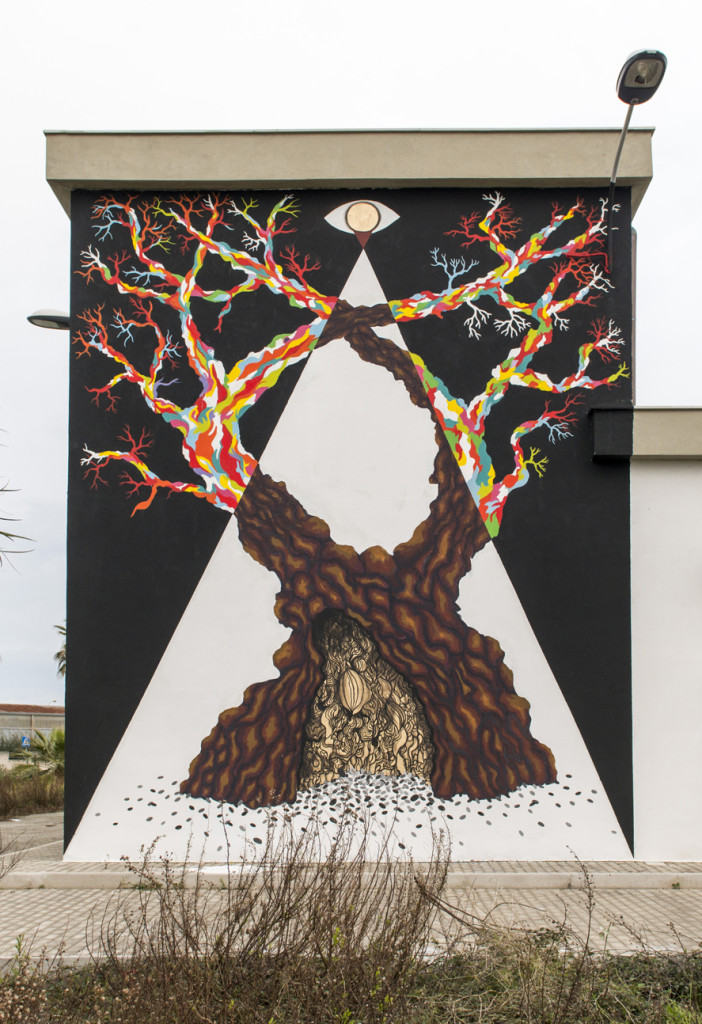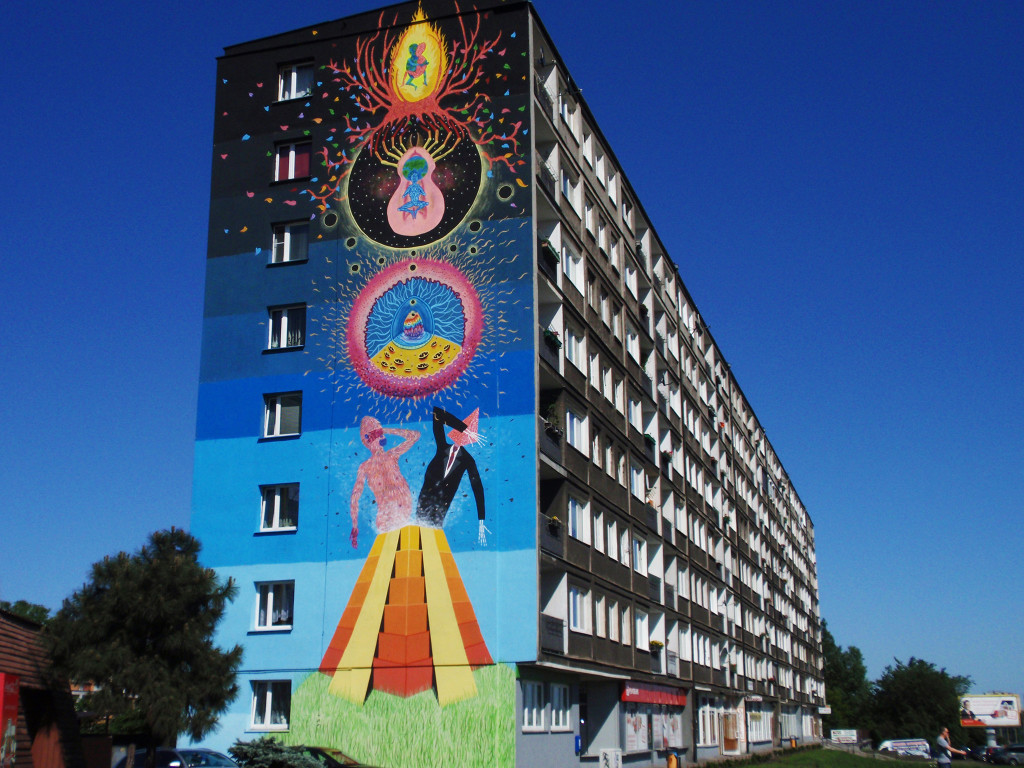Quella di Gola Hundun è un’arte intrecciata alla vita e strettamente legata al mondo della natura in tutte le sue componenti, attraverso un sapiente uso del colore misto ad una forte carica spirituale e mistica mostra il legame viscerale e primordiale instaurato tra l’uomo e la biosfera.
Abbiamo scambiato con lui quattro parole cercando di immergerci nel suo travolgente universo tanto affascinante quanto intricato.
La tua produzione impressiona subito per la grande varietà delle proposte: dalla street art alle opere su tela, dalla scultura ai disegni su carta, dalle installazioni al video. Questa pluralità testimonia la presenza di basi solide che ti danno la possibilità di spaziare, qual è stato perciò il percorso formativo che ti ha portato fin qui?
Diciamo che sicuramente gli anni passati tra il liceo artistico a Ravenna e l’Accademia di Bologna mi hanno lasciato delle basi tecniche, per quanto negli anni successivi al coronamento degli studi abbia provato a sradicarle, spingendo verso un tipo di segno più naif e punk. In un secondo momento, mano a mano che la mia produzione sotto il nome di Gola cresceva, sono andato reintegrando ciò che avevo appreso durante gli studi a ciò che avevo indagato nei miei esperimenti personali tanto in strada come in studio, arrivando così al mio segno odierno. Mi piace abbracciare varie discipline per mettermi in gioco perché sono curioso ma anche perché ogni lavoro è legato a una visione, e di volta in volta scelgo il mezzo che mi sembra più efficace per rappresentarla.
La prima cosa che si nota guardando il tuo lavoro è sicuramente la presenza di un legame quasi viscerale con il mondo della natura, protagonista assoluta delle opere che realizzi. Da cosa deriva questa relazione e perché scegliere di renderla così centrale?
Se non avessi scelto il sentiero dell’arte avrei voluto essere naturalista, a volte mi chiedo come sarebbe stata la mia vita. L’attrazione che il regno animale e vegetale esercitano su di me è stata molto forte sin da piccolo e la necessità di sentirmi avvolto in atmosfere non antropomorfizzate è sempre più incisiva, d’altra parte già testi babilonesi parlavano dei problemi di estraniazione e le patologie che nascevano nella vecchia Uruk, come non percepirlo oggi. Questa propensione innata verso il regno naturale è sicuramente stata rafforzata dalla scelta del vegetarianesimo tra i 15 e i 16 anni che mi ha portato ad sentire questo legame ancora più radicalmente.
La scelta stessa di essere attivo nel campo dell’arte urbana può essere considerata secondo te un modo per collocare opere all’infuori della sacralità dello spazio museale e quindi a contatto diretto con il mondo esterno?
Penso che la parte interessante di fare lavori nello spazio esterno, tanto urbano come naturale o rurale, è che gli stessi potranno essere visti da occhi non necessariamente preparati a riceverli, e per la maggior parte dei casi accoglieranno un pubblico non complice al mondo dell’arte. Per questo lasciare qualcosa nel mondo esterno come dici tu, è sempre un atto politico, perché genera sempre un interrogativo dietro gli occhi del fruitore, o almeno lo era fino alla fase mainstream che sta vivendo il muralismo contemporaneo, forse…
Alcuni tuoi lavori, come ad esempio “The Call”, sembrano voler trasmettere con la loro forte carica emotiva un vero e proprio monito, invitano a farci riflettere su come l’ambiente non sia spesso giustamente tutelato e a volte anche deturpato. Quanto pensi sia importante caricarsi di questo tipo di messaggi: la natura sta gridando, noi siamo pronti ad ascoltarla?
Io penso che saremmo pronti. E’ evidente come la sensibilità collettiva sia molto più attenta rispetto a temi come lo specismo, l’ecologia, l’utilizzo di biotecnologie…
Esempi banali, la dieta vegana è sulla bocca di tutti, e capita sempre più spesso ultimamente di incappare in programmi pro green sui media. Mi riferisco al fatto che qualcosa è cambiato a livello popolare se lo rapportiamo anche solo agli anni 90, e te lo dico come vegetariano di “vecchia guardia”, si nota una voglia di cambiamento verso l’equità ed il “sostenibile” e sulla spinta di questo sentire popolarizzato si osserva la creazione di tanti piccoli gruppi spontanei di azione diretta e di sensibilizzazione.
Il fatto è che in realtà il sistema reale pilotato dai grandi interessi economici non è praticamente cambiato (se non con piccole eccezioni locali) e non ha interesse a farlo, per fare un esempio tra i vari possibili, il protocollo di Kyoto non è ancora stato messo in pratica, in maniera seria, da nessuna nazione.
Il problema vero a mio parere è che noi umani non ci sentiamo da secoli (soprattutto in occidente) parte della natura, si può denotare anche dalla formulazione della tua domanda, invece siamo tutti parte dell’ecosistema, e se l’equilibrio naturale cadrà la sfera umana verrà assolutamente influenzata. Le nostre generazioni vivranno certamente questo cambio epocale, stiamo già vivendo il cambio climatico dato dallo scioglimento dei poli il quale pare sia oramai inarrestabile, la moria delle api che significa anche complicazioni dell’agricoltura, l’estinzione di massa delle specie animali odierne.
Quindi per rispondere alla tua domanda “ …noi siamo pronti ad ascoltarla?” rispondo con un’altra domanda: Siamo pronti ad accettare di essere la causa principale della situazione odierna della biosfera? Penso che solo accettando di essere un unico pianeta potremmo attivarci verso la risoluzione del disequilibrio che stiamo vivendo.
Sono particolarmente rimasto colpito dall’opera “Rebirth”, che hai realizzato in Kazakistan in occasione del festival Artbat Fest nel 2013. Tale lavoro sembra quasi essere la summa di tutta la tua produzione, una sorta di manifesto non solo artistico ma anche spirituale: anche tematiche come la spiritualità e lo sciamanismo sono infatti a te molto care, vuoi parlarci allora più nel dettaglio della suddetta interessantissima composizione ma anche del perché molte tue creazioni possiedono questa inclinazione mistica?
“Rebirth” è nato dalla volontà di simbolizzare una sorta di rinascita dell’uomo occidentale contemporaneo attraverso il ricongiungimento consapevole con il resto del pianeta. La figura umana che si scorge piccolina sulla cima dell’elemento centrale è in realtà la protagonista e metro di misura per leggere il pezzo. Un uomo che spogliato di tutto, persino dei capelli, come fosse un bambino, s’immerge nelle acque da cui la vita stessa è nata, per riemergere con la coscienza di essere una parte del tutto.
Vorrei aggiungere che il murale è diviso in tre registri: la parte centrale che rappresenta il mondo, il pianeta terra, la nostra casa, la parte inferiore sul suolo rappresenta
l’inframondo, le acque eterne, il brodo primordiale e la parte superiore, l’ultramondo il cosmo, l’infinitamente grande.
Questa suddivisione trina a lettura verticale si può trovare nella descrizione dell’aldilà di molte delle grandi religioni del passato, tra cui vorrei citare quella Maya, quella Norse, ma si può ritrovare anche nello stesso aldilà Cristiano che a sua volta prende spunto da altre culture pagane specialmente quella greca antica.
La componente mistica fa parte del mio lavoro, in quanto fa parte della mia vita. Il creare per me come per molti, è cercare di condividere i miei ideali i miei sogni e le mie preoccupazioni, portare un messaggio seppure non sempre evidente.
Ancora più recente è invece la realizzazione a Bari di “Olio Santo”, curato dai ragazzi di Pigment Workroom. Vuoi parlarci di questo progetto e di quali significati si porta con sé?
Il desiderio di fare qualcosa che mi permettesse di porre un poco di attenzione sulla questione Xylella è nato durante la mia permanenza in Salento per il Viavai Project, dove ho potuto passeggiare sotto le fronde mutilate di oliveti secolari.
La rabbia e l’incredulità generate dalla corsa alle potature e gli abbattimenti forzati anche dall’unione europea, sono stati l’ispirazione per lavorare sul progetto “Olio Santo” realizzato nel capoluogo pugliese con gli amici di Pigment Workroom che mi hanno dato l’opportunità sviscerare e riconvertire il tema in varie forme, disegno, pittura, murales…
La questione degli ulivi pugliesi rimane ancora oscura, io continuo a pensare che sia legata a interessi speculativi, per questa ragione ho incorporato elementi simbolici della massoneria e l’oro nella composizione. Vi invito ad informarvi dell’ assunto attraverso internet, c’è un articolo/petizione molto interessante su change.org proprio in questi giorni.
Da un punto di vista più tecnico i tuoi lavori sono delle vere e proprie sinfonie di colore: camaleontici, psichedelici e policromatici, il colore stesso genera le forme e ce le rende nella loro unicità. Quanta centralità dai nella tua produzione ad un aspetto come il cromatismo?
Un caro amico direbbe ora che il colore è il linguaggio con cui l’assoluto parla allo spirito. Ad ogni modo, il linguaggio del colore è fondamentale per me, al di la delle scelte cromatiche che faccio istintivamente, e quelle veicolate da contrasti percettivi “classici”, ultimamente sono interessato alla chiave di lettura esoterica del colore e ai significati dei colori dell’aura. Il colore di per se è messaggio, bisogna conoscere la lingua per parlarla correttamente.
“The Walkman” si pone come obiettivo quello di lasciare spazio e visibilità ai giovani talenti come te. Cosa ti senti di suggerire a chi ha deciso o sta decidendo di investire la propria vita nella creatività?
Il mio consiglio è in realtà il consiglio che darei a qualsiasi individuo che comincia un lavoro, un avventura, o che semplicemente comincia. Credi in te stesso e in ciò che pensi sia giusto, condividilo e difendilo, ma impara ad ascoltare.
Non arrenderti davanti né alle prime né alle seconde difficoltà, perché in ogni mestiere e in ogni cammino ve ne sono molte, ma pressoché tutte si possono risolvere.
Insisti, sii tenace.
Viaggia molto, osserva, si curioso, cerca di parlare un linguaggio che possa essere capito da più orecchie possibili.
Sii attivo e positivo, perché non è quello che il sistema si aspetta da te.
Divertiti.
Gola Hundun Sito Ufficiale: www.golahundun.com
Facebook: www.facebook.com/golahundun
[divider]ENGLISH VERSION[/divider]
Gola Hundun ’s art is woven to life and strictly linked to the world of nature in all of its components, through a skillful use of color mixed to a strong spiritual and mystic tension shows the innate and primordial connection established between man and biosphere.
We nattered with him trying to sink into his passionate universe, fascinating as much as intricate.
Your production immediately impresses for the big variety of proposals: from street art to canvas paintings, from sculpture to paper drawings, from installations to videos. This plurality testifies the presence of strong bases that give you the chance to range. So, what kind of educational path brought you here?
We could say that the years passed in the arts high school in Ravenna and in the Academy of Bologna surely left me technical bases, although I tried to uproot them during the years after the successful completion of my studies, moving to a kind of more naif and punk sign. Later, with the growth of my production under the name of Gola, I gradually integrated what I had learned during my studies with things I had examined in my personal experiments in the street as in study room, arriving this way to my current sign. I like embracing different disciplines to give myself a challenge, because I’m curious but also because every work is linked to a vision, and each time I choose the instrument which seems the most effective to represent it.
The first thing that comes to attention looking at your work is certainly the presence of an almost innate link with the world of nature, absolute protagonist of the works you realize. From what does this connection derivate, and why you chose to make it so central?
If I didn’t choose the road of art I’d want to be a naturalist, sometimes I wonder how would have my life been. The attraction that animal and vegetal reigns exercise on me has always been very strong since when I was a kid, and the need to be wrapped in not antropomorphic atmospheres is more and more incisive; after all, even Babilonese texts talked about problems of alienation and pathologies which born in ancient Uruk, how couldn’t we perceive it nowadays? This innate propensity towards natural reign has surely been strengthened by the choice of vegetarianism between 15 and 16 that brought me to feel this connection even more radically.
The choice itself of being active in the urban art field may be considered to you as a way to put works outside the sacrality of museum space and so in contact with the outside world?
I think that the interesting part of working in open space, urban as well as natural or rural, is that works can be seen by eyes not necessarily prepared to see them, and in most cases will welcome an audience not acquainted with the world of art. For this reason, letting something in the outside world as you say is always a politic act, because generates a question behind beneficiary’s eyes, or at least it was until the mainstream phase which contemporary muralist is living, maybe…
Some of your works, as “The Call”, seem to want to communicate with their emotional charge an out-and-out warning, invite us to think about how the environment is often wrongly unprotected and sometimes defaced as well. How much do you think is important to carry this kind of message : nature is screaming, are we ready to listen to it?
I think that we would be ready. It’s clear how collective sensibility is much more alert on themes as speciesism, ecology, use of biotechnologies…
As ordinary examples, everyone talks about vegan diet, and lately it is more and more often you run into pro green programs on mass media. I mean that something has changed at community level if we compare even with 90s, and I say it as an “old guard” kind of vegetarian; you can notice the feel of change towards equality and “Eco-friendly” and in the wake of this common feel you can observe the creation of many little spontaneous groups of direct action, acting for awareness.
The fact is that the real system, based on profits has not actually changed (excluding little local exceptions) and is not interested in doing it. Picking one of much examples, the Kyoto protocol hasn’t been put into practice yet, in a serious way, by any country.
The real problem to me is that we as humans haven’t feel part of nature for centuries (especially in the Occident), it’s easy to see also in the formulation of your question, but we are all part of the ecosystem, and if the natural balance will drop, the human sphere will be heavily influenced. Our generations will surely live this epochal change, we are already living the climate change resulting from ice-melting in the Poles which seems unstoppable, the death of bees which also means a complication for agriculture, the mass extinction of current animal species.
So, answering your question “…are we ready to listen to it?” I answer with another question: are we ready to ear that we are the main cause of the present situation of the biosphere? I think that we could activate towards the resolution of the imbalance that we are living, only by accepting to be an only planet.
I have been particularly impressed by the work “Rebirth”, which you realized in Kazakistan on the occasion of the Artbat Fest festival in 2013. That work seems almost to be the summa of your whole production, kind of a manifesto not only artistic but spiritual too: also contents like spirituality and shamanism are important to you. So, do you want to tell us more in detail about the above-mentioned interesting composition? And why do a lot of your creations have this mystic inclination?
“Rebirth” was born from the decision of symbolize a sort of rebirth of the contemporary Occidental man through the conscious reunification with the rest of the planet. The little human figure that can be seen on top of the central element is actually the protagonist, and the measure that has to be applied to read the piece. A man who took off everything, even hair, like a child, dives into water from which life itself was born, only to re-emerge with the awareness of being part of the whole.
I’d like to add that the mural is divided into three registers: the central part that represents world, planet Earth, our home; the lower part on the ground represents inter-world, eternal waters, primordial soup; last, the upper part is ultra-world, cosmos, the infinitely big.
This tripartition with vertical reading can be found in descriptions of afterlife by lots of ancient religions, among which I’d like to mention the Maya and Norse ones. But you can also find it in the Christian afterlife that takes the cue from different pagan cultures, especially the ancient Greek one.
The mystic component is part of my work, because is part of my life. Creation, for me as for much people, consists in trying to share my ideas, dreams and worries, bringing a message even if not always evident.
Even more recent is the realization in Bari of “Olio Santo” (“Holy Oil” T.N.), edited by the guys of Pigment Workroom. Would you like to tell us about this project and meanings it brings with itself?
The will of doing something that could make me able to drive some attention on the Xylella issue was born during my visit in Salento for Viavai Project, where I could have a walk under amputee fronds of centuries-old olive trees. Angry and shock generated by the pruning race and pulling down forced also by European Union, have been the inspiration for working on my project “Olio Santo” realized in the county seat of Puglia with friends from Pigment Workroom who gave me the chance to examine the theme fully and convert it into different shapes as drawing, painting or murals.
The issue of Pugliese olive trees is still unclear, I keep thinking that it’s linked to speculative profits, and for this reason in the composition I incorporated symbolic elements with masonry and gold. I recommend you to enquire about this on Internet, exactly in these days there is an interesting article/petition on change.org
From a more technical point of view your works are actual symphonies of colors: chameleonic, psychedelic and polychromatic, the color itself generates shapes and give them to us in all their unicity. How many centrality do you give in your production to chromaticism?
A dear friend of mine would say that color is the language with which the absolute talks to the spirit. Anyway, language of color is fundamental to me. Leaving out the chromatic choices that I make on an instinctive base or the ones that are influenced by “classic” perception contrasts, I’m lately interested in the esoteric interpretation of color and in meanings of aura colors. Color itself is a message, we need to know the language to speak it properly.
“The Walkman” goal is to leave space and visibility to young talents like you. What would you say to anyone who has decided or is deciding to invest his/her life in creativity?
My suggestion is actually the suggestion that I would give to everyone who starts a job, an adventure or simply starts. Believe in yourself and in what you think is right, share and defend it, but also learn to listen.
Don’t give up towards the first or second difficulties, because in every job, in every road, there are many, but almost every of them can be solved.
Go on, be tenacious.
Travel a lot, look around, be curious, try to speak a language that can be understood by as much ears as possible.
Be active and positive, because this is not what the system expects you to be.
Enjoy.
Gola Hundun Official Website: www.golahundun.com
Facebook: www.facebook.com/golahundun
Traduzione a cura di Eleonora Martelli

